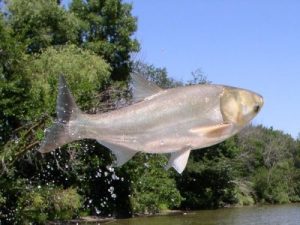
Great Lakes resource managers can now determine rivers that may be vulnerable to Asian carp spawning if they were to spread into the Great Lakes Basin, according to a new U.S. Geological Survey report.
Findings indicate that silver and bighead carp may be able to spawn in more Great Lakes tributaries than previously estimated. The new information could help resource managers implement control measures and potentially prevent Asian carp from becoming established in the Great Lakes.
The USGS study characterized the minimum habitat requirements for successful Asian carp spawning. Results indicate that Asian carp can successfully spawn in river stretches as short as 16 miles, which is considerably shorter than the 62 miles previously thought to be required.
Scientists analyzed water temperature, streamflow, and water quality in two Lake Michigan tributaries (the Milwaukee and St. Joseph rivers) and two Lake Erie tributaries (the Maumee and Sandusky rivers). Findings and techniques from the report can be used to identify other rivers vulnerable to Asian carp spawning in the future.
Although Asian carps primarily live in slow-moving water, they require streams with a fast current, sufficient length and turbulence to spawn. After eggs are released, they drift in the current while developing. The eggs are slightly heavier than water and require turbulent flowing water to remain adrift.
A long stretch of uninterrupted river provides a better chance for the eggs to survive and hatch. If the eggs sink to the bottom and gather in areas with slower flows, known as “settling zones,” they generally die.
All four Great Lakes tributaries studied exhibited sufficient temperatures, water-quality characteristics, turbulence and transport times outside of settling zones for Asian carp eggs to mature and hatch.
Even though all four rivers had settling zones, findings indicate that under the right temperature and flow conditions, river reaches as short as 16 miles may allow Asian carp eggs sufficient time to develop to the hatching stage.
Bighead carp and silver carp have become established in Mississippi River Basin. Both species are threatening to spread into the Great Lakes.
Asian carp are invasive species that could pose substantial environmental risks and economic impacts to the Great Lakes if they become established.
The USGS report was funded by the Great Lakes Restoration Initiative as administered by the U.S. Environmental Protection Agency.
source: U.S. Department of the Interior, U.S. Geological Survey